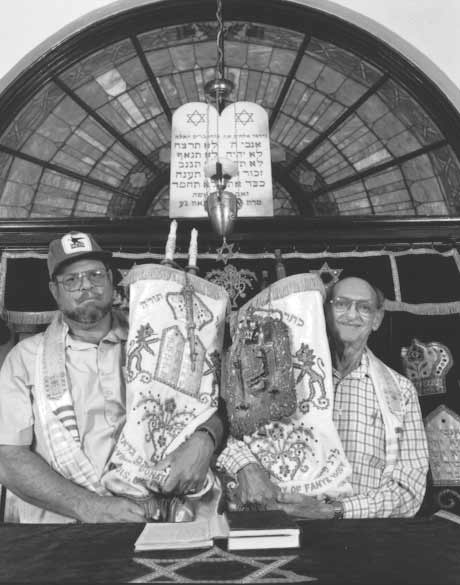

|
National Public Radio aired two
segments on Jewish life in the South. Click here for the links. You will hear Joe Erber's voice, and also, davenning. Joe Erber and his late uncle, Meyer Gelman, were photographed by Bill Aron at Ahavath Rayim Synagogue, Greenwood, Mississippi, in 1990. Scroll below for large version of photo. |
| This widely published photo by Bill Aron is from his collection on Jewish life in the south, and is in the permanent collection of the Museum of the Southern Jewish Experience in Utica, Miss. Below you'll find a very large blowup and more about Congregation Ahavath Rayim of Greenwood, Mississippi. | Delta Jews, a film by Michael DeWitt "about Jews in the land of the blues," was broadcast by PBS all over the US. The film, which premiered at the 1999 New York Jewish Film Festival, was narrated by the Jewish playwright, Alfred Uhry. The prize-winning Uhry, whose works include "Driving Miss Daisy," has been called by some "The bard of the South." |

| Joe Erber
(left) in his Post Office hat, and his uncle, Meyer Gelman, posed for this now-famous photograph in the Synagogue of Congregation Ahavath Rayim in Greenwood, Miss. Photographer Bill Aron is graciously letting us use it on our web page. |
|||
| Meyer was a charter member of synagogue This photo of Meyer Gelman and his nephew, Joe Erber, in their orthodox synagogue in Greenwood, was taken by California photographer Bill Aron as part of a survey of Jewish life in the American South, and it has been celebrated in publications and exhibitions all over the world. We are grateful to Stephen Gelman, Meyer's son, for bringing it to our attention, and to his wife, Barbara, for sending it to us.
Why Mississippi? Their youngest child, Meyer, was only four years older than their oldest grandchild, Marvin Fink, who turned 77 years old in February, 1999. "Meyer and I grew up more like brothers than uncle and nephew," the internet and web-savvy Fink said in a May, 1999 E-mail, explaining just why Ike had chosen Mississippi. Synagogue was central A two-minute walk to synagogue
from our house, so we were always there, at least until high school days." Norma and her husband, Martin Sarvis, very much enjoy their life in Israel. "We live not far from the Mediterranean...we just like it here," she said. Ready for intensive Hebrew The traveling rabbi Decline since heyday in the 1950's
Vicksberg closed first Concern leads to museum Gelman photos in permanent collection |